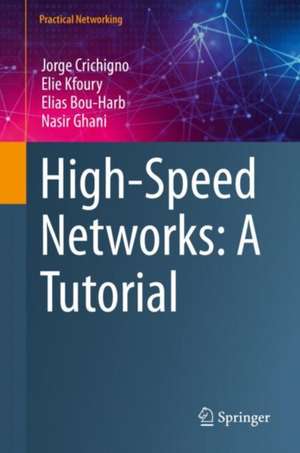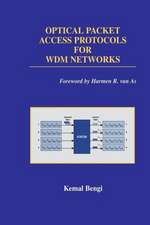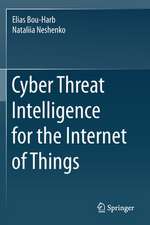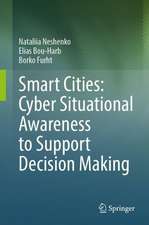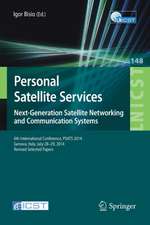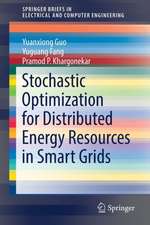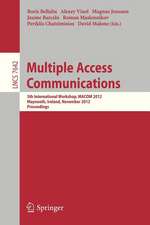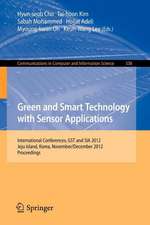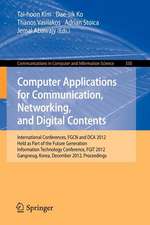High-Speed Networks: A Tutorial: Practical Networking
Autor Jorge Crichigno, Elie Kfoury, Elias Bou-Harb, Nasir Ghanien Limba Engleză Hardback – 19 apr 2022
This book provides practical knowledge and skills on high-speed networks, emphasizing on Science Demilitarized Zones (Science DMZs). The Science DMZ is a high-speed network designed to facilitate the transfer of big science data which is presented in this book. These networks are increasingly important, as large data sets are now often transferred across sites. This book starts by describing the limitations of general-purpose networks which are designed for transferring basic data but face numerous challenges when transferring terabyte- and petabyte-scale data.
This book follows a bottom-up approach by presenting an overview of Science DMZs and how they overcome the limitations of general-purpose networks. It also covers topics that have considerable impact on the performance of large data transfers at all layers: link layer (layer-2) and network layer (layer-3) topics such as maximum transmission unit (MTU), switch architectures, and router’s buffer size; transport layer (layer-4) topics including TCP features, congestion control algorithms for high-throughput high-latency networks, flow control, and pacing; applications (layer-5) used for large data transfers and for maintenance and operation of Science DMZs; and security considerations. Most chapters incorporate virtual laboratory experiments, which are conducted using network appliances running real protocol stacks.
Students in computer science, information technology and similar programs, who are interested in learning fundamental concepts related to high-speed networks and corresponding implementations will find this book useful as a textbook. This book assumes minimal familiarity with networking, typically covered in an introductory networking course. It is appropriate for an upper-level undergraduate course and for a first-year graduate course. Industry professionals working in this field will also want to purchase this book.
| Toate formatele și edițiile | Preț | Express |
|---|---|---|
| Paperback (1) | 398.39 lei 43-57 zile | |
| Springer International Publishing – 20 apr 2023 | 398.39 lei 43-57 zile | |
| Hardback (1) | 547.13 lei 43-57 zile | |
| Springer International Publishing – 19 apr 2022 | 547.13 lei 43-57 zile |
Preț: 547.13 lei
Preț vechi: 683.92 lei
-20% Nou
Puncte Express: 821
Preț estimativ în valută:
104.69€ • 109.60$ • 86.63£
104.69€ • 109.60$ • 86.63£
Carte tipărită la comandă
Livrare economică 07-21 aprilie
Preluare comenzi: 021 569.72.76
Specificații
ISBN-13: 9783030888404
ISBN-10: 3030888401
Pagini: 796
Ilustrații: XV, 462 p. 718 illus., 701 illus. in color.
Dimensiuni: 155 x 235 mm
Greutate: 0.84 kg
Ediția:1st ed. 2022
Editura: Springer International Publishing
Colecția Springer
Seria Practical Networking
Locul publicării:Cham, Switzerland
ISBN-10: 3030888401
Pagini: 796
Ilustrații: XV, 462 p. 718 illus., 701 illus. in color.
Dimensiuni: 155 x 235 mm
Greutate: 0.84 kg
Ediția:1st ed. 2022
Editura: Springer International Publishing
Colecția Springer
Seria Practical Networking
Locul publicării:Cham, Switzerland
Cuprins
Introduction to high-speed networks and science DMZ.- Network cyberinfrastructure aspects for big data transfers.- Data link and network layer considerations for large data transfers.- Impact of TCP on high-speed networks and advances in congestion control algorithms.- Application and security aspects for large flows.- Security aspects.- Challenges and open research issues.
Notă biografică
Jorge Crichigno received the Ph.D. degree in computer engineering from The University of New Mexico, Albuquerque, USA, in 2009. He is currently an Associate Professor with the College of Engineering and Computing, University of South Carolina (USC), and the Director of the Cyberinfrastructure Laboratory, USC. His work has been funded by private industry and U.S. agencies, such as the National Science Foundation (NSF), the Department of Energy (DOE), and the Office of Naval Research (ONR). He has over 15 years of experience in the academic and industry sectors. His research interests include implementation of high-speed networks and Science Demilitarized Zones (Science DMZs), P4 programmable switches, network security, TCP optimization, offloading functionality to programmable switches, and IoT security. Dr. Crichigno is an ABET evaluator, and has served as panelist for NSF and as Technical Program Committee member for several IEEE conferences.
Elie F. Kfoury iscurrently pursuing the Ph.D. degree with the College of Engineering and Computing, University of South Carolina, USA. He previously worked as a research and teaching assistant in the computer science and ICT departments at the American University of Science and Technology in Beirut. He is a member of the CyberInfrastructure Laboratory at the University of South Carolina, where he conducts research on high-speed networks, TCP congestion control, performance measuring, buffer sizing, and routing protocols, and P4 programmable switches.
Elias Bou-Harb received the Ph.D. degree in computer science from Concordia University, Montreal, Canada. He was a Senior Research Scientist with Carnegie Mellon University (CMU), where he contributed to federally funded projects related to critical infrastructure security. He is currently the Director of the Cyber Center for Security and Analytics, University of Texas at San Antonio (UTSA), where he leads, co-directs, and co-organizes university-wide innovative cyber security research, development, and training initiatives. He is also an Associate Professor with the Department of Information Systems and Cyber Security specializing in operational cyber security and data science as applicable to national security challenges. His research interests include operational cyber security, attacks’ detection and characterization, malware investigation, cyber security for critical infrastructure, and big data analytics. He was a recipient of five best research paper awards, including the prestigious ACM’s Best Digital Forensics Research Paper.
Nasir Ghani received the Ph.D. degree in computer engineering from the University of Waterloo. He is currently a Professor with the Electrical Engineering Department, University of South Florida. He is also a Research Liaison with Cyber Florida. He also spent several years working with large Blue-Chip organizations (IBM, Motorola, Nokia) and several hi-tech startups. His research has been supported by the National Science Foundation, Defense Threat Reduction Agency, Department of Energy, Qatar Foundation, and Sprint-Nextel. His research interests include cyberinfrastructure networks, cybersecurity, cloud computing, disaster recovery, and cyber-physical systems. He received the NSF CAREER Award in 2005, and the Best Paper Awards at IEEE PIMRC 2017 and IEEE ANTS 2010. He was the Chair of the IEEE Technical Committee on High-Speed Networking (TCHSN) and has served as an Associate Editor for several IEEE journals.
Textul de pe ultima copertă
This book provides practical knowledge and skills on high-speed networks, emphasizing on Science Demilitarized Zones (Science DMZs). The Science DMZ is a high-speed network designed to facilitate the transfer of big science data which is presented in this book. These networks are increasingly important, as large data sets are now often transferred across sites. This book starts by describing the limitations of general-purpose networks which are designed for transferring basic data but face numerous challenges when transferring terabyte- and petabyte-scale data.
This book follows a bottom-up approach by presenting an overview of Science DMZs and how they overcome the limitations of general-purpose networks. It also covers topics that have considerable impact on the performance of large data transfers at all layers: link layer (layer-2) and network layer (layer-3) topics such as maximum transmission unit (MTU), switch architectures, and router’s buffersize; transport layer (layer-4) topics including TCP features, congestion control algorithms for high-throughput high-latency networks, flow control, and pacing; applications (layer-5) used for large data transfers and for maintenance and operation of Science DMZs; and security considerations. Most chapters incorporate virtual laboratory experiments, which are conducted using network appliances running real protocol stacks.
Students in computer science, information technology and similar programs, who are interested in learning fundamental concepts related to high-speed networks and corresponding implementations will find this book useful as a textbook. This book assumes minimal familiarity with networking, typically covered in an introductory networking course. It is appropriate for an upper-level undergraduate course and for a first-year graduate course. Industry professionals working in this field will also want to purchase this book.
Caracteristici
Describes the limitations of general-purpose networks for transferring big science data across wide area networks Topics are reinforced with hands-on virtual laboratory experiments Laboratory experiments are conducted with relevant production-grade virtual appliances
